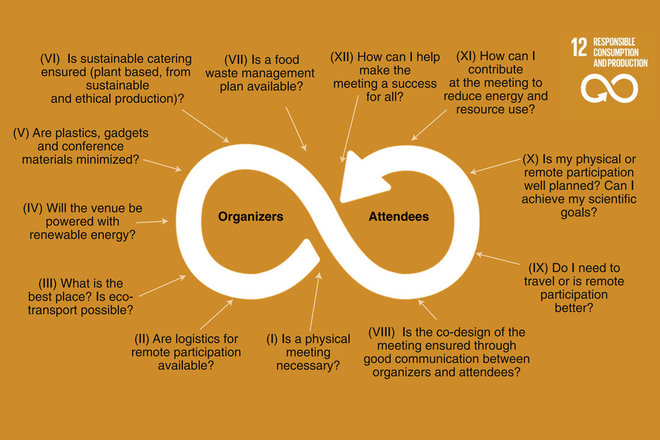04/29/2020, 18:19
The arrow was going into the inverse direction than the number-counting. It was accidentally - and unnoticed - 'turned around' during last editing steps of the paper. Here arrows and numbers look now into the same directions:) Note that the direction of the arrow pointer is the only difference from the original SDG12 logo. Have a look here sustainabledevelopment.un.org/sdg12 and check out SDG communication material here www.un.org/sustainabledevelopment/news/communications-material/
Neue Begründung: ***How to make meeting more sustainable: checklist for organisers***
**I) Is a physical meeting necessary?**
Whether the environmental footprint of a meeting is appropriate depends crucially on the expected scientific outcome of the meeting. Tools such as telephone or video conferencing allow to substitute physical meetings effectively in most cases, saving travel times, financial and organizational resources as well as environmental impacts. For long-distance participants, remote participation should be default and physical participation justified only for team-building with new colleagues. Meetings serving mainly for exchange of information or broader discussions can be organized remotely
**II) Are logistics for remote participation available?**
Even if organizing a physical meeting, physical presence may not be possible or necessary for all attendees. Good audio/video facilities are essential allowing active remote participation, and make emote participation a real alternative. Expenses for equipment at high quality should stand in an appropriate proportion to travel expenses, and should be considered in project funding.
**III) What is the best place? Is eco-transport possible?**
The location of the venue should be chosen considering accessibility by attendees. Using public transport and trains should be preferred over air travel.
**IV) Will the venue be powered with renewable energy?**
Select a venue that uses energy from renewable sources. Appropriate temperature standards should be chosen to ensure participants comfort (avoid overheating or over-cooling).
**V) Are plastics, gadgets and conference materials minimized?**
Use tap water, avoid plastic wrapping/ cutlery, printed material and give-aways.
**VI) Is sustainable catering ensured (plant-based, from sustainable and ethical production)?**
Plant-based and healthy meals should be the default for environmental and public health reasons. Food should be sourced from socially and environmentally sustainable supply chains, respecting high ethical standards.Early engagement with caterers and food suppliers can ensure planning of a healthy, tasty and sustainable catering.
**VII) Is a food waste management plan available?**
Avoid food waste and over-consumption, for example by offering fewer food choices and implementing food waste prevention and management plan.
**VIII) Is the co-design of the meeting ensured through good communication between organizers and attendees?**
The *Cercedilla Manifesto* conceives sustainable meetings as the result of a co-creative process that must engage both conference organizers and attendants. Good communication among organizers and attendees is crucial to raise awareness and reach the set sustainability goals. Fully remote meetings as well as physical meetings with remote participation need to adapt their communication style. For example, virtual break-out groups can allow for in-depth and casual discussions also in larger remote meetings. New digital collaboration tools that were developed for virtual collaboration (e.g. parallel working on living documents) can enrich also purely physical meetings.
***How to make meeting more sustainable: checklist for attendees***
**IX) Do I need to travel or is remote participation better?**
Once meeting goals have been defined and known by all parties, together with options for remote and physical attendance, the individual decision to travel is taken under consideration of maximizing the meetings' sustainability.
**X) Is my physical or remote participation well planned? Can I achieve my scientific goals?**
Regardless of physical or remote participation, attendance to meetings needs to be well prepared.
**XI) How can I contribute at the meeting to reduce energy and resources use?**
Each participant must be responsible for their own energy use during the meeting. This goes from avoiding unnecessary towel washing to switching off lights and electronic devices if they are not in use.
**XII) How can I help make the meeting a success for all?**
Take advantage of the meeting. If physical attendance is finally chosen, try to enjoy as much as possible in a multi-dimensional way: scientifically, culturally and socially. Keep in mind the environmental implications of your decisions regarding the meetings’ participation.
Signatures at the time of the change: 162



